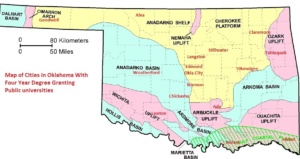
When we published longtime Capitol reporter Jeff Packham’s news story on Oklahoma’s higher-education budget cuts last week, we were glad to see so many people cared about the topic. Many readers chastised lawmakers for slicing higher-ed funding by about $190 million over the past seven years of Gov. Mary Fallin’s tenure.
But we also heard some people dismissing the criticisms offered by Oklahoma Council on Public Affairs president Jonathan Small as wrong-headed or unnecessary. The OCPA has historically pushed a narrative that Oklahoma universities — particularly OU and OSU — spend a great deal of money on administrative functions that could be considered superfluous.
The truth, as usual, likely lies somewhere in between, or at least it appears that way thanks to numerous instances of poor optics among Oklahoma’s higher education system.
While smaller Oklahoma colleges have struggled to absorb substantial percentage cuts, OU and OSU have endured with greater flexibility for several reasons: Those institutions have increased undergraduate student enrollment, increased their reliance on private donations and positively streamlined some administrative functions.
But instead of being lauded at the Oklahoma State Capitol for creative budgeting efforts, the university system as a whole has routinely rolled lawmaker and lobbyist eyeballs by appearing flush in their advocacy efforts and for hiring former politicians at administrative salaries that surpass most professors on campuses.
If Oklahoma’s higher education system wants to succeed in restoring its painfully diminished appropriations, it will need to highlight more student success stories and limit its optics problems.
Chowing down in the name of college degrees
One such optical faux pas occurred during the 2017 legislative session. On April 18, Oklahoma’s higher education leaders rallied to support Oklahoma’s Promise, a critical scholarship program that allows qualified young people the opportunity to attend state colleges or universities.
RELATED
Oklahoma’s universities struggle with budget cuts by Jeff Packham
But for anyone who missed the day’s speeches on the Capitol’s second floor, the event’s highlights were deliciously off message. Dozens of “extra” Chick-fil-A sandwich boxes lined tables on the second floor, and displays in the fourth-floor rotunda featured free cupcakes and Dippin’ Dots ice cream for public consumption (see photo above).
While some media — including NonDoc — took advantage of the dessert offerings, numerous lawmakers and lobbyists griped anonymously about how the “underfunded” higher education system could finance such a picnic.
In reality, small signs with even smaller print noted how the food companies had donated their wares to fill Capitol bellies. But that nuance was lost in the grand scheme of the higher education debate. The free food had pleased many, yet it had undercut the narrative of beleaguered universities focused on shaping young Oklahoma minds.
Toss in a few stadium expansions for sports, enormous salaries for coaches and the public’s wide misconception about where athletic dollars come from — plus how that money helps back-fill OU and OSU academic efforts — and it’s no wonder young legislators and seasoned conservative think tanks are skeptical.
What will the future hold?
If OCPA and higher-education advocates have been pushing competing perspectives on this topic for years, one development of the 2017 legislative session might bring each side a step closer to the middle.
Former GOP Gov. Frank Keating was named to the OU Board of Regents this year. Keating is also on the board of OCPA, though that position is not listed in his OU biography.
Whether Keating’s OU appointment will place a critical eye on university expenditures and revenue schemes remains to be seen., but perhaps some creative agreements could be struck. Like many universities, OU has made millions selling student information to companies like Bank of America that peddle credit cards. Could GOP leadership pass statute protecting student information from credit marketers by line-iteming $20 million for some university program?
Or might Keating’s greater exposure to the important work being done by OU (and other universities) simply tamper OCPA criticism of Oklahoma’s higher education system?
Either way, the state needs a more robust discussion of exactly what revenue-needing programs and cost-cutting opportunities mutually exist for the state’s network of colleges and universities.






















